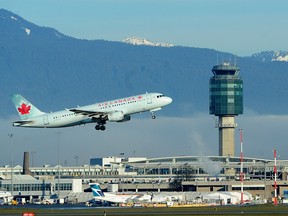
Article content
For careful observers, Tuesday’s federal budget had some highly interesting things to say about the future role of Canada’s airports, which is a welcome development considering their importance to our economy, our trade relationships and our connectivity to the rest of the world.
THIS CONTENT IS RESERVED FOR SUBSCRIBERS ONLY
Subscribe now to read the latest news in your city and across Canada.
- Exclusive articles from Barbara Shecter, Joe O'Connor, Gabriel Friedman, and others.
- Daily content from Financial Times, the world's leading global business publication.
- Unlimited online access to read articles from Financial Post, National Post and 15 news sites across Canada with one account.
- National Post ePaper, an electronic replica of the print edition to view on any device, share and comment on.
- Daily puzzles, including the New York Times Crossword.
SUBSCRIBE TO UNLOCK MORE ARTICLES
Subscribe now to read the latest news in your city and across Canada.
- Exclusive articles from Barbara Shecter, Joe O'Connor, Gabriel Friedman and others.
- Daily content from Financial Times, the world's leading global business publication.
- Unlimited online access to read articles from Financial Post, National Post and 15 news sites across Canada with one account.
- National Post ePaper, an electronic replica of the print edition to view on any device, share and comment on.
- Daily puzzles, including the New York Times Crossword.
REGISTER / SIGN IN TO UNLOCK MORE ARTICLES
Create an account or sign in to continue with your reading experience.
- Access articles from across Canada with one account.
- Share your thoughts and join the conversation in the comments.
- Enjoy additional articles per month.
- Get email updates from your favourite authors.
THIS ARTICLE IS FREE TO READ REGISTER TO UNLOCK.
Create an account or sign in to continue with your reading experience.
- Access articles from across Canada with one account
- Share your thoughts and join the conversation in the comments
- Enjoy additional articles per month
- Get email updates from your favourite authors
Sign In or Create an Account
or
Article content
For example, funding has been restored to the Airports Capital Assistance Program, which will support important safety-related upgrades at local and regional airports. There are also nods to lease extensions and ground rent formulas, which are important questions for airports and their many stakeholders.
Article content
Article content
Article content
The language that will invariably attract the most attention is about the government considering “new ways to attract private-sector investment” and “options for the privatization of airports.” I’ll come back to that. But first, let’s unpack the most important item, which is actually the $5 billion earmarked for trade and transportation infrastructure projects, with airports and ports highlighted as “central to diversifying Canada’s trade.”
Article content
By signing up you consent to receive the above newsletter from Postmedia Network Inc.
Article content
Recognition of that piece is everything right now, because Canada is in the early days of a fundamental realignment from its old economy and airports are square in the middle of it all. New tariffs are being priced in and new trade corridors and alliances are being forged. Digital technologies are disrupting lives and businesses.
Article content
Canada’s airports, which already generate more than $120 billion in annual economic output and support nearly 436,000 jobs, are going to be key enablers of this change. If you are exploring new markets or revamping your supply chains, you will often be flying or connecting as a passenger through Toronto, Vancouver or Montreal. If you’re shipping or engaging in e-commerce, your goods will likely land on the same runways in the belly of a plane.
Article content
Article content
Canada’s big hubs have already been working to accommodate such changes. It’s not that airport planners saw Donald Trump and the tariff wars coming — it’s that their job is to watch the long-term trends in demographics, population and GDP growth, international destinations and connections data, remote work and labour markets.
Article content
Article content
This careful forecasting informs the infrastructure choices Canada’s hub airports have been making. The pandemic accelerated changes in where people go and why — fewer short hops, more experiential travel and international leisure trips. Labour shortages and supply-chain issues have nudged airlines toward using fewer, larger planes, which has put new demands on arrival halls, gates, runways, digital infrastructure and transit connections. Terminal spaces and cargo facilities need to be right-sized and hyper-efficient.
Article content
To accommodate these new realities and drive more passenger and economic growth, two of those three big hubs —Toronto Pearson and Montreal-Trudeau — have recently launched multi-year building programs. They weren’t waiting on this year’s budget to start financing their work, but it does reflect the changing world they’ve been planning for.

.jpg) 9 hours ago
2
9 hours ago
2
 English (US)
English (US)